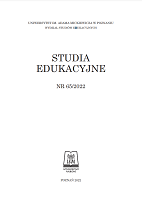OBSERVATION WORKSHEET FOR THE DEVELOPMENT OF SELF-REGULATION OF 2- TO 3-YEAR-OLD CHILDREN (AOS)
Observation Worksheet for the Development of Self-Regulation of 2- To 3-Year-Old Children (AOS)
Author(s): Alicja PotorskaSubject(s): Preschool education, Educational Psychology, Developmental Psychology, Sociology of Education, Pedagogy
Published by: Uniwersytet Adama Mickiewicza
Keywords: psychosocial development of a young child; scale to observe the development of the self-regulation ability; early childhood education; early interventions for psychosocial development;
Summary/Abstract: This article presents the results of verifying the psychometric validity of a tool developed to investigate the developmental changes taking place in children attending nurseries, aged 2 to 3 years. The tool was used in research on the conditions created in nurseries for children of toddler age. It discusses the theoretical underpinnings of the concept of diagnosing early education environments and the assumptions designating the structure of the questionnaire measuring the effects of development of young children in the scope of self-regulation. The studies served to empirically validate the concept of the diagnosis of early care and education milieus and verify the validity of the psychometric tools to diagnose the effects of development of children aged 2 to 3 years. The study made use of the pedagogical monograph method and the observation technique. In order to carry out a longitudinal study with two measurements in the period from December 2017 to July 2018, 5 tools were developed, including the scale described in this article. A total of 131 children of toddler age attending 10 groups in 4 institutions and 20 caregivers working with them on a regular basis were included in the study. Subsequently, the results of the verification of the psychometric validity of the tool were presented: Cronbach’s alpha reliability coefficient, average correlations between items in both measures, and Pearson’s correlation coefficient (r) indicating the agreement between two judges. The psychometric validity of a scale is confirmed by data concerning high reliability and accuracy. Factor analysis was used to modify the sub-scale measuring the self-regulation capacity developed on the stage of tool development. The psychometric values obtained for the tool suggest that it can be aptly applied to forecast and monitor the development of the self-regulation of young children and, consequently, that it may contribute to creating more conducive conditions for them and assist the development of this ability.
Journal: Studia Edukacyjne
- Issue Year: 2022
- Issue No: 65
- Page Range: 117-135
- Page Count: 19
- Language: Polish

